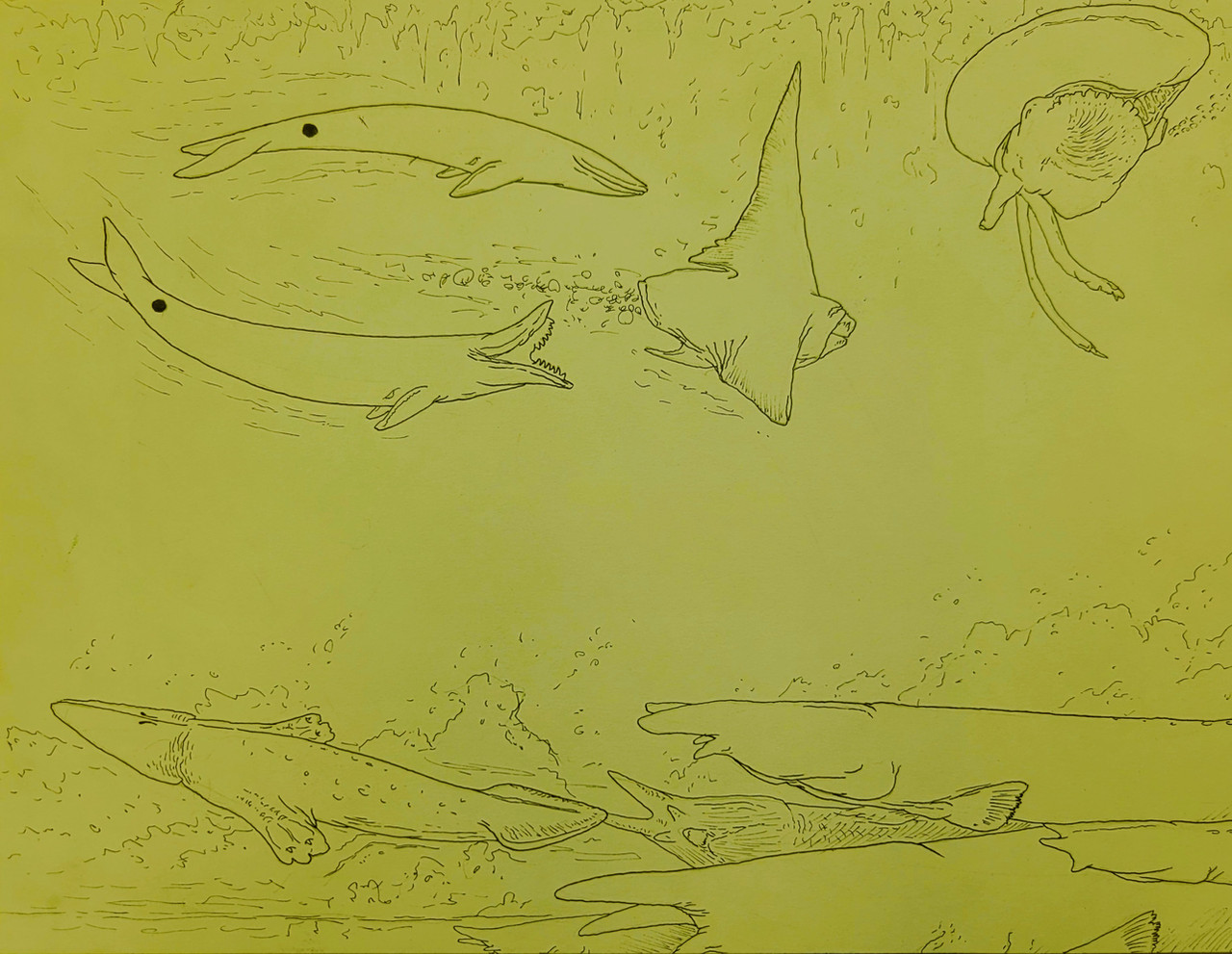HOME | DD
 poo-stinker — Greenwater Predators
poo-stinker — Greenwater Predators

#aliencreature #alienplanet #alienspecies #creaturedesign #lovecraftianhorror #thalassophobia #creatureconcept #creaturemonster #speculativeevolution #eldritchabomination #speculativebiology #creaturefantasy #speculativezoology #lovecraftiancreatures
Published: 2022-06-12 07:20:04 +0000 UTC; Views: 8952; Favourites: 96; Downloads: 7
Redirect to original
Description
A burst of activity in the stagnant coastal waterways popularly known as “greenwater” due to the profusion of lime-green marine algae that covers the surface and stains the water a murky green. Despite this, it is actually quite clean, nutrient rich, and very favorable to life. In the foreground, a pod of “loaches”, large, social bottom-dwellers specialized in big game hunting, frighten an Arrowhead out of the sediment and give chase. The loaches have what, while not true jaws, can be considered identical in function. A pair of serrated, keratinous plates situated in their sucking mouths are able to clamp down and pull back, ripping out flesh and forcing it down the throat. There are no bones in this arrangement, purely muscle, and the system is derived from ancestors who fed on sedentary animals dredged up from the seafloor, and before that it came from humble creatures who ate the mud itself. While they are still blind, thrashing bottom feeders, the biggest loaches can reach sixty feet in length and are considered apex predators. If they catch the Arrowhead, they will erase its presence with lethal, gasping bites in mere seconds.
In the background, another hunt unfolds. A pair of Black Moon Grinwhales, highly derived predatory Cthulutherids, close in on a jet-propelled algae eater. While most grinwhales live in large schools and are comparable in size to small dolphins, this particular variety reaches thirty feet in length and hunts in pairs. They are the largest of their kind and more than capable of taking down big game, including their giant filter-feeding relatives. Just like the unrelated loaches, Grinwhales lack true jaws. Instead, they have evolved a lining of knifelike, keratinous “teeth” along the center of each of their muscular facial appendages. While more basal forms can still move these tentacular appendages independently, which serves excellently for subduing small prey, the macropredatory Grinwhales have essentially fused their tentacles, which allows them to grapple and rip apart large and powerful marine animals. They process food much like monitor lizards, ripping out large chunks and swallowing them whole. A single bite is devastating and can easily slice open the algae eater’s rubbery hide, fatally rupturing organs.
Grinwhales have a gentle side, however. This particular species has an incredibly strong pair bond. This is not even reproductive in origin, as pairs will stay together even if they are incapable of mating. They have a strong dependence on cooperation for survival and have been observed to exhibit symptoms of what is essentially anxiety when on their own. Pairs do everything together, sleeping under the algae nuzzled against each other, cleaning each other’s skin, and, if possible, raising young. Grinwhales are live-bearing and may rear up to twenty young, who go off and form their own pods with other litters until they mature enough to form pairs.
Unlike the cetaceans they resemble, Grinwhales are not exceptionally intelligent, comparable to the smarter varieties of Earth fish. They are somewhat curious and skilled hunters but lack the social complexities of dolphins. Simply put, they are sharks that swim like whales.
Nearby hovers a floater snail. It is not a snail but is similar enough to mollusks to be named after them. This Lovecraftian beast has a thin, brittle shell filled with gas, allowing it to hover near the surface clouded in algae, where it waits for small prey to swim by. Floater snails come from a large and complex family and have many less threatening relatives, and they themselves are common predators in warm, murky coastlines. They propel themselves not unlike a squid and spear prey with a long, prehensile tendril tipped with a venomous spine. They are not especially bright but exhibit some very simple and usually food related curiosity, and they seem to have some capacity for memory as individuals have been observed returning to spots where they had caught prey previously. Young are free swimming and planktonic, becoming more sedentary as their shells develop.
Related content
Comments: 8

👍: 1 ⏩: 0

👍: 1 ⏩: 1

👍: 1 ⏩: 1

👍: 1 ⏩: 0

👍: 1 ⏩: 0

👍: 1 ⏩: 0

👍: 1 ⏩: 1

👍: 2 ⏩: 0
























